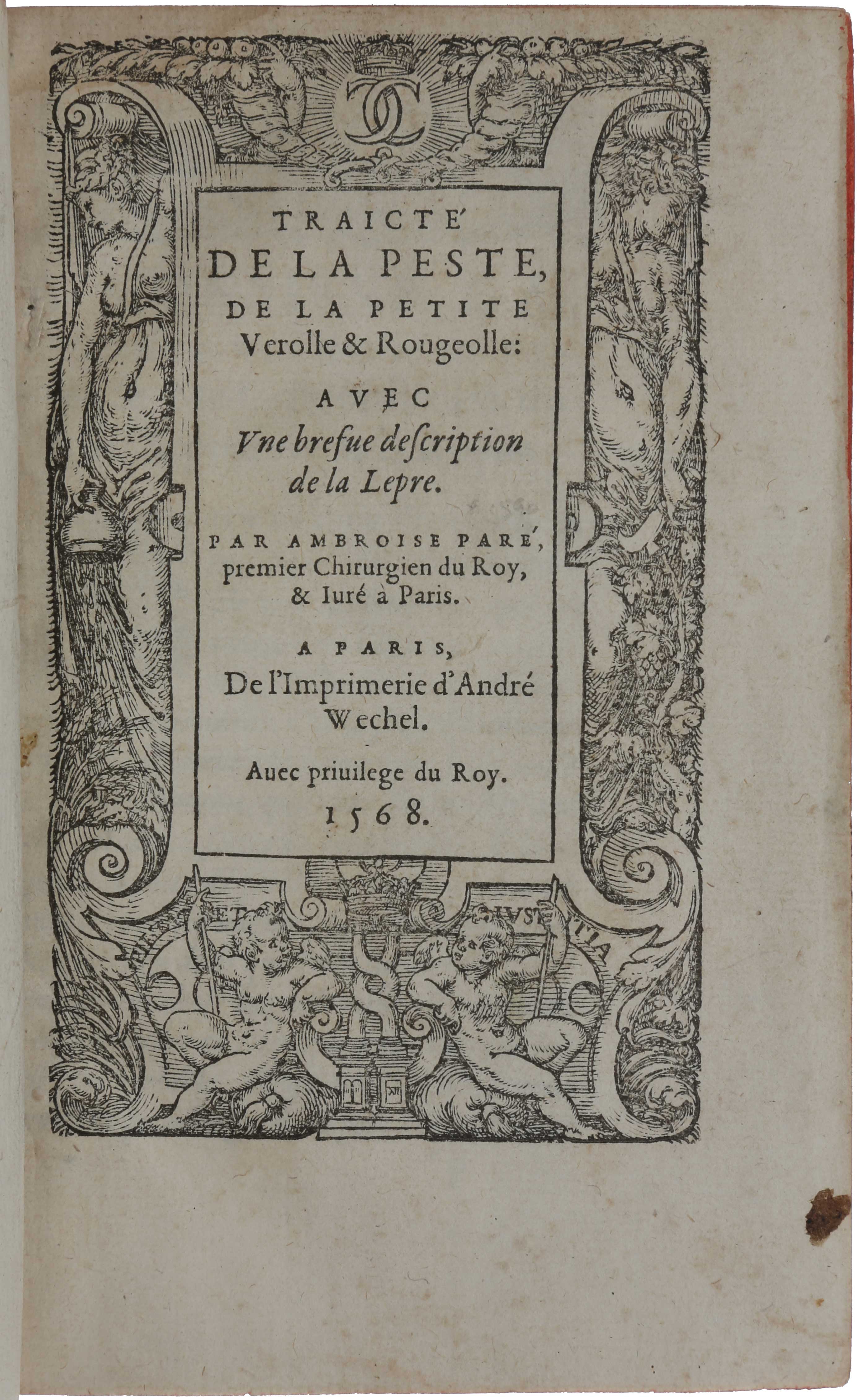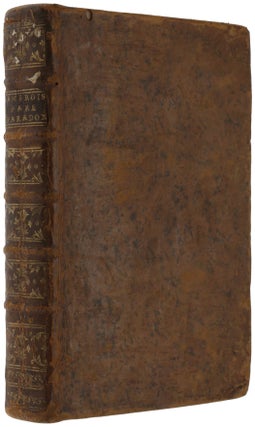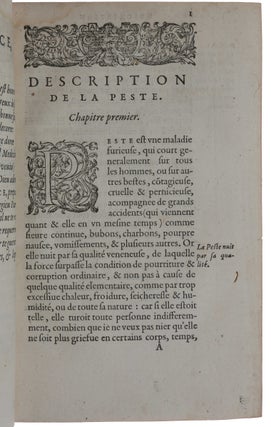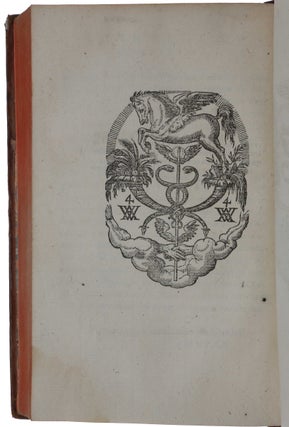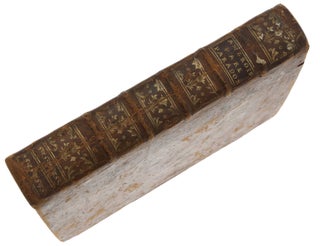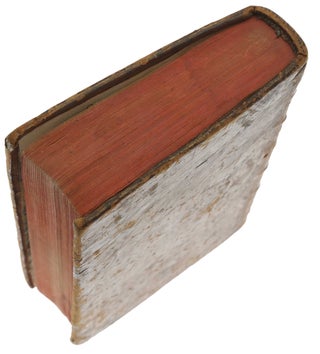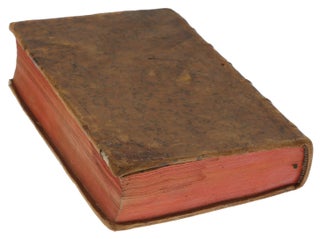Traicté de la peste, de la petite verolle & rougeolle: avec une brefve description de la lepre.
Paris: André Wechel, 1568. First edition of Paré’s extremely rare treatise on the plague, smallpox and measles, based upon his own direct observations of these diseases, “one of his best works” (Thornton, p. 63). “Having passed the winter of 1564-65 on tour in Provence with Catherine de Medici and the young King Charles IX, where the ravages of a plague epidemic, added to poverty and general misery, were painfully apparent, Paré was requested by the queen mother to make whatever knowledge he possessed of the disease available to the world. He therefore puts into a book his ideas as to its cause, transmission, and treatment, and says he writes only of what he has seen by long experience during his three years at the Hôtel-Dieu, his travels, his practice in Paris, and his own slight attack while he was serving his internship. This is one of Paré’s most systematic treatises; for its careful symptomatology and thorough description of treatment, it deserves to rank among the best of his writings” (Doe). “His practical measures in regard to hygiene and quarantine are excellent in most respects, although he followed the generally prevalent idea that bonfires of aromatic woods, such as juniper and pine, should be made throughout the streets to purify the air. He humanely urges that, ‘The magistrates must have all sick folks attended by physicians, surgeons, and apothecaries, good men, of experience: and must treat those that are attacked and isolate them, sending them to places set apart for their treatment, or must shut them up in their own houses (but this I do not approve, and would rather they should forbid those that are healthy to hold any converse with them) and must send men to dress and feed them, at the expense of the patients, if they have the means, but if they are poor, then at the expense of the parish. Also they must forbid the citizens to put up for sale the furniture of those who have died of the plague’” (Packard, pp. 80-81). “Paré’s original books, all very rare today, were handy volumes, small enough for the field surgeon’s knapsack” (Hagelin, p. 35). COPAC lists Wellcome only. ABPC/RBH list only one other copy, in a rebacked 19th century binding and with the final four leaves re-margined (Sotheby’s, 15 June 2005, lot 49, €18,000). The present copy, in a 17th century binding, is entirely unrestored. “Because such a high proportion of those who suffered the symptoms of plague died from it, and in a very short space of time, it was not a disease to which people could ever become inured. Every outbreak appeared like a divine judgement. The medical men acknowledged this divine origin of plague. Ambroise Paré, surgeon to four French kings and the most celebrated surgical innovator of his day, devoted a chapter of his 1568 book on plague to ‘the Divine causes of an extraordinarie Plague’, claiming that: ‘It is confirmed, constant, and received opinion in all Ages amongst Christians, that the Plague and other Diseases which violently assail the life of Man, are often sent by the just anger of God punishing our offences. The Prophet Amos hath long since taught it, saying Shall there be affliction, shall there be evil in a Citie, and the Lord hath not done it? On which we truly we ought always to meditate … For thus we shall learn to see God, our selves, the Heaven and Earth, the true knowledge of the causes of the Plague, and by a certain Divine Philosophy to teach, God to be the beginning and cause of the second causes, which well without the first cause cannot go about, nor attempt, much less perform any thing. For from hence they borrow their force, order, and constancy of order; so that they serve as instruments for God, who rules and governs us, and the whole World, to perform all his works, by that constant course of order, which he hath appointed unchangeable from the beginning. Wherefore all the cause of a Plague is not to be attributed to these near and inferior causes or beginnings, as the Epicures, and Lucianists commonly do.’ [This and subsequent quotations from Paré are from the English translation of the present work, A Treatise of the Plague, London: Thomas Johnson, 1630.] “Thus only atheists and scoffers would claim that plague has only natural (secondary) causes. However the first cause – God – customarily acts through secondary causes, so Paré as a medical man could then immediately turn to the natural causes of plague to discuss its causes, course, and cure. “Paré’s account of plague, which was written at the request of the French queen-mother, Catherine de Medici, after a widespread outbreak of the disease in France in 1565, is one of the classic descriptions of the disease, and indicates how painful and fearsome it was. In Paré’s view, the ‘first original’ of plague was a corruption of the air, entering the body and reaching the heart, ‘the Mansion, or as it were the Fortress or Castle of Life’, where it acted like a poison, attacking the vital spirit. If the vital spirit is weak, it ‘flies back into the Fortress of the Heart, by the like contagion infecting the Heart, and so [it infects] the whole Body, being spread into it by the passages of the Arteries’. The pestiferous poison brought about a burning fever, whose effects drove sufferers to desperate measures. They had ulcerated jaws, unquenchable thirst, dryness and blackness of the tongue, ‘and it causeth such a Phrensy by inflaming the Brain, that the Patients running naked out of their beds, seek to throw themselves out of Windows into the Pits and Rivers that are at hand’. “Because he saw plague as a poison, a poison which acted on the heart and then on the blood, Paré’s first concern in treatment was to provide an antidote, which by its specific property would defend the heart from the poison by opposing the specific power of the poison. It had to be quick-acting, since the poison itself was very swift. Paré’s antidote of choice was a mixture of treacle and mithridatium, an ancient drug compounded of up to 60 different ingredients and thought to be a sovereign protection against poison. Taken inwardly or applied outwardly over the region of the heart and to the carbuncles, this antidote draws the poisons out ‘as Amber does Chaff’, and then digests the poison and robs it of its deadly force. If the plague came with eruptions or little red spots all over the body (these are the famous ‘tokens’ of the plague), caused by the poison increasing the heat of the blood, Paré advocated that a ‘drawing’ medicine should be applied, such as pig’s grease mixed with mercury and herbs, to draw the poison through the skin. Alternatively, he suggests, ‘if any noble or gentleman refuse to be anointed with this unguent, let them be enclosed in the body of a Mule or Horse that is newly killed, and when that is cold let them be laid in another; until the pustules and eruptions do break forth, being drawn by the natural heat’ of the animal’s corpse. “Even worse than the fever or the red spots in plague were the distinctive and painful ‘buboes’ (or carbuncles), hard black tumours which appeared in the neck, armpits and groin. Following classical Greek medical teaching, Paré saw these buboes as ‘emunctories’, natural outlets for the infected matter draining from the three main organs of the body, the brain, heart and liver respectively. The pain of the buboes was so intense that sufferers wanted to have them lanced by the surgeon, the pain increasing as the bubo hardened and ripened. Paré’s remedy was to apply ointment, then a cupping-glass heated very hot; kept on for a quarter of an hour this would draw the poison from the bubo. Alternatively, ‘when you see, feel and know, according to reason, that the Bubo is come to perfect suppuration, it must be opened with an incision knife, or an actual or potential cautery.’ A ‘potential cautery’ is a corrosive of some kind which produces the same burning effect on the skin as a real cautery, such as a red-hot iron. But sufferers would also take desperate measures themselves in their agony: ‘There are many that for fear of death have with their own hands pulled away the Bubo with a pair of Smith’s pincers; others have digged the flesh round about it, and so gotten it fully out. And to conclude, others have become so mad, that they have thrust a hot iron into it with their own hand, that the venom might have a passage forth’. “If a bubo was so painful that the sufferer wanted to tear it out, yet worse was what Paré called ‘a pestilent carbuncle’: ‘A Pestilent Carbuncle is a small tumour, or rather a malign pustule, hot and raging, consisting of blood vitiated by the corruption of the proper substance … In the beginning it is scarce so big as a seed or a grain of Millet or a Pease … but shortly after it increaseth like unto a Bubo unto a round and sharp head, with great heat, pricking pain, as it if were with needles, burning and intolerable, especially a little before night, and while the meat is in concocting, more than when it is perfectly concocted. In the midst thereof appeareth a bladder puffed up and filled with sanious (bloody) matter. If you cut this bladder you shall find the flesh under it parched, burned and black, as if there had been a burning coal laid there, whereby it seemeth that it took the name of Carbuncle; but the flesh that is about the place is like a Rainbow, of divers colours, as red, dark green, purple, livid, and black; but yet always with a shining blackness, like unto stone pitch, or like unto the true precious stone which they call a Carbuncle, whereof some also say it took the name. Some call it a Nail, because it inferreth like pain as a nail driven into the flesh … a Bubo and Carbuncle are tumours of a near affinity, so that the one doth scarce come without the other’. “In his attempt to provide the best advice for the treatment of plague, Paré had consulted widely amongst his fellow practitioners during the plague of 1565, asking all those that he came across as he travelled with Charles IX’s court to Bayon, what their experience had taught them about the value of bleeding and purging in treatment for plague. They all agreed that those affected with the plague who were bled or purged all grew progressively weaker and died. So from this communal experience of medical men, Paré urged that bleeding and purging be discontinued in the plague” (Cunningham & Grell, pp. 280-284). “Paré was born at Laval near Mayenne. His education was meagre and he never learned Latin or Greek. A rustic barber surgeon’s apprentice when he came up from the provinces to Paris and afterwards a dresser at the Hôtel Dieu, the public hospital in Paris, he in 1537 became an army surgeon. France was at this time engaged in many wars: against Italy, Germany and England, and eventually at home, in the civil war so disastrous to the Huguenots. Paré joined the Forces and for the next thirty years, with a foothold in Paris in the intervals of fighting, he engaged in any campaign where he soon made himself the greatest surgeon of his time by his courage, ability, and common sense. Like Vesalius and Paracelsus he did not hesitate to thrust aside ignorance or superstition if it stood in his way. Although snubbed by the physicians and the Medical Faculty at the University and ridiculed as an upstart because he wrote in his native tongue instead of in Latin, his reputation gradually grew and he became surgeon successively to Henry II, Francis II, Charles IX and Henry Ill. It is said that Charles IX protected Paré during the Massacre of St. Bartholomew by hiding him in his bedchamber. Paré’s work is here bound after the first edition in French (first, in Italian, 1584), of a rare treatise in dialogue form by Silvestro Facio on the epidemic of plague in Milan: Paradoxes de la peste, ou il est monstré clairement comme on peut viure & demeurer dans les villes invectées, sans crainte de la contagion. Traduicts en François par B. Barralis (Paris: F. Bourriquant, 1620). 8vo, pp. [viii], 252, [2]. Krivatsy 3870. One of the most interesting texts on the question of contagion was written by Silvestro Facio after the Milan epidemic of 1576 … Paradoxes of the Plague, in which is clearly shown how one can live and stay in infected cities without fear of contagion adopts the device already used by Boccaccio’s Decameron: during seven days of conversations, Facio and his interlocutors debate not just whether the plague is contagious, but whether belief in contagion may not itself have deadly consequences. ‘All the plagues of which we have learned through historians have been caused by the price of food and beverages, earthquakes, a large quantity of unburied dead bodies or cadavers, ponds and swamps, or else by infected air resulting from Celestial figures, and southerly winds.’ Measures of isolation that governments may take are thus useless, causing unnecessary disruptions, ruining commerce, and impeding vital communications. Above all, Facio argues, one should resist the view that the plague is contagious. ‘To believe that one contracts the plague by touching the hand of the cloak of a plague victim is more dangerous for the alteration of the mind than any disease’” (Huet, p. 31). Cunningham & Grell, The four horsemen of the Apocalypse: religion, war, famine and death in reformation Europe, 2008; Doe, A bibliography of the works of Ambroise Paré, 14; Durling 3526; Hagelin, Rare and important medical books in the Karolinska Institute, 1989; Huet, The culture of disaster, 2012; Packard, The life and times of Ambroise Paré (1510-1590), 1926; Tchemerzine V, 36; Thornton, Medical books, libraries and collectors, 1949; Waller 7162. Not in Adams, BM STC, Osler, Honeyman or Norman.
“Paré is responsible for the abolition of the method of applying hot iron or boiling oil in the treatment of gunshot wounds, the new feature of Renaissance surgery. During a battle in which the supply of oil gave out, Paré was forced to treat many with a mixture of egg-yolk, oil of roses, and turpentine. He was surprised to find the next morning that those treated with his mixture was in much better condition than the others, and he at once championed the new method. Control of hemorrhage by ligation of arteries had been frequently recommended but it was Paré who first practiced it systematically and brought it into general use. He invented many new surgical instruments, devised new methods in dentistry for extracting teeth, filling cavities, and making artificial dentures. He describes an artificial hand from iron, and also artificial noses and eyes of gold and silver” (Hagelin, pp. 34-35).
8vo, pp. [xvi], 235 (recte 275), [4] (last leaf blank) (light browning and dampstaining, minor marginal worming). With woodcut title-border and woodcut printer’s device at end. Seventeenth-century calf, spine with floral gilt decoration and lettering-piece (minor worming to upper part of spine, lightly rubbed). A very good and large copy, entirely unrestored.
Item #4567
Price: $55,000.00

